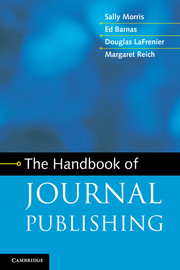Book contents
- Frontmatter
- Contents
- Preface and acknowledgments
- 1 Introduction to journals
- 2 Managing journals
- 3 Editing
- 4 The production process
- 5 Journal metrics
- 6 Marketing and sales
- 7 Fulfillment
- 8 Journal finances
- 9 Subsidiary income
- 10 Contract publishing
- 11 Copyright and other legal aspects
- 12 Ethical issues
- 13 The future of scholarly communication
- Appendix 1 Glossary
- Appendix 2 Resources
- Appendix 3 Vendors
- Index
- References
3 - Editing
Published online by Cambridge University Press: 05 March 2013
- Frontmatter
- Contents
- Preface and acknowledgments
- 1 Introduction to journals
- 2 Managing journals
- 3 Editing
- 4 The production process
- 5 Journal metrics
- 6 Marketing and sales
- 7 Fulfillment
- 8 Journal finances
- 9 Subsidiary income
- 10 Contract publishing
- 11 Copyright and other legal aspects
- 12 Ethical issues
- 13 The future of scholarly communication
- Appendix 1 Glossary
- Appendix 2 Resources
- Appendix 3 Vendors
- Index
- References
Summary
Introduction
Without editors, journals would not happen.
The Oxford English dictionary (OED) defines “editor” as “a person who is in charge of and determines the final content of a newspaper, magazine, or multi-author book.”
However, in the field of scholarly journals, the terms “editing” and “editor” cover a particularly broad range of activities; to add to the confusion, the precise terminology used to describe the roles within this range varies widely among publishers, and elements of these roles may be combined in numerous different ways.
Broadly speaking, editorial roles fall into two distinct functional areas. On the one hand, there is the “content acquisition” role – generally carried out by a specialist in the journal’s subject area. The journal Editor, in this sense of the word, will fit the OED definition: he or she will be responsible for deciding what does and does not appear in the publication. There may be a more complex team fulfilling aspects of this role – this is discussed in more detail below.
On the other hand, there is the “process and management” role – the preparation of the content for publication, as well as the overall business management of the journal. This type of editorial role is exercised within the publisher’s offices (or under its control). Although it is often forgotten by those who assert that publishers are no longer a necessary part of the scholarly communication chain, Editors carry out a most valuable job, clarifying (and often correcting) the author’s text and, vitally for online journals, checking the references to ensure that they can be linked wherever possible to the publications to which they refer. For online journals, they also prepare digital files for publication and make decisions about how the content will be presented.
- Type
- Chapter
- Information
- The Handbook of Journal Publishing , pp. 75 - 103Publisher: Cambridge University PressPrint publication year: 2013



